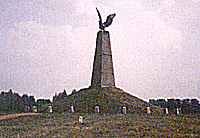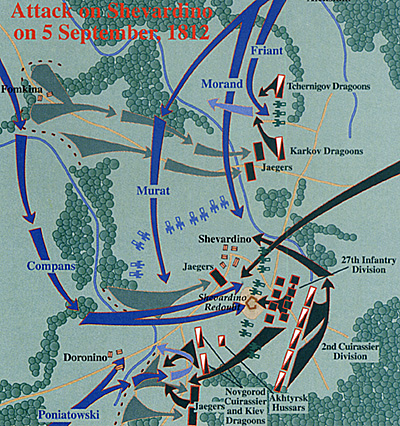The Shevardino Redoubt was the site of a fierce battle two days prior to the main engagement. In many ways, this fight was a microcosm of the combat to follow, a tenacious and brave Russian defense matched by a series of intrepid French assaults, with an inordinate price in lives paid by both sides given the relative insignificance of the terrain.
 French monument near the Shevardino redoubt, site of the battle on 5 September, marks Napoleon's headquarters during the battle of Borodino two days later.
French monument near the Shevardino redoubt, site of the battle on 5 September, marks Napoleon's headquarters during the battle of Borodino two days later.
For reasons not fully explained, the Russians elected to make a preliminary stand at Shevardino, a position nearly one mile in advance of their main line around Borodino. Approximately 18,000 Russian troops would be committed to this forward defense, but initially the brunt of the fighting fell upon General Neverovski, former commander of the famous Pavlov Grenadier Regiment, and his 27th Infantry Division of Bagration's 2nd Army of the West.
Napoleon, delighted to see the Russians exposed and at last willing to give battle, ordered Marshal Davout's 1st Corps to attack the redoubt from the north, while Prince Poniatowski's smaller 5th Polish Corps executed a flanking movement from the south-west. Two French reserve cavalry corps, the 1st and 2nd, were ordered to support the attack, and waited nearby.
The Shevardino Redoubt was an irregular six sided earthwork, with one entrance open to the east. The longest side of the work was approximately 50 yards long, and its walls were about 4 or 5 feet high, with a ditch dug in front of it, so that troops at the bottom of the gully would have to climb up nearly 10-12 feet to reach the defenders.
Compan's 5th French Division spearheaded the assault on the Shevardino Redoubt. Unable to storm it by bayonet, and prepped by intensive skirmish fire, Compan's men engaged in a fierce short-range firefight that would last nearly an hour. Ultimately Compan's bold use of his supporting artillery swept the Russians from the position.
The work was taken by the famed French "Terrible 57th" Regiment along with the French 61st Line Regiment. According to Baron Gourgaud, once inside the redoubt the French attackers found no Russians left alive, so destructive had the effects of the skirmish fire and close-up artillery proven.
Russian cavalry counter-attacks momentarily swept over the position, cutting up one unfortunate battalion and inflicting losses on the remaining infantrymen - but the French clung to the redoubt.
In addition to Poniatowski's ineffective attack, sharp fighting raged over the Shevardino village, where Morand's and Friant's Divisions of Davout's 1st Corps engaged Prince Mecklenbourg's 2nd Grenadier Division. Here, the inspirational Prince Bagration displayed his customary bravery, personally leading the counter-attack that stabilized the Russian right flank from complete envelopment and temporarily re-took the redoubt.
The fighting which had begun in the late afternoon lasted well after nightfall, when Bagration withdrew his command with the sizable loss of more than 6,000 men (more than a third of the Russians engaged). The French, having suffered slightly fewer casualties, were left holding the wreckage of the redoubt, the exhausted infantry spending the night in square as a precaution against any further cavalry charges.
During the battle of Borodino two days later, Napoleon made his headquarters in the vicinity of the Shevardino Redoubt, where he had a limited vantage point from which to observe the battle.

More Battle of Borodino
-
Borodino: Introduction
Borodino: Situation in 1812
Borodino: Invasion
Borodino: Battlefield Park
Borodino: Opposing Plans
Borodino: 1: Shevardino Redoubt
Borodino: 2: Borodino Village
Borodino: 3: Bagration Fleches
Borodino: 4: Utitza Village
Borodino: 5: Semenovskaya
Borodino: 6: Great Redoubt (Raevsky Redoubt)
Borodino: Epilogue for a Draw
Borodino: Travel Tips
Borodino: The First Historians
Borodino: Strengths at Borodino
Borodino: Estimating Battle Losses
Borodino: Museum
Borodino: Order of Battle (Text: fast)
Borodino: Russian Order of Battle (Graphics: extremely slow: 587K)
Borodino: French Order of Battle (Graphics: extremely slow: 639K)
Back to Table of Contents -- Napoleon #14
Back to Napoleon List of Issues
Back to MagWeb Master Magazine List
© Copyright 1999 by Napoleon LLC.
This article appears in MagWeb (Magazine Web) on the Internet World Wide Web.
The full text and graphics from other military history magazines and gaming magazines are available at http://www.magweb.com
Order Napoleon magazine direct